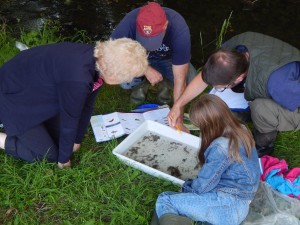Those of you who like the seaside may well have collected a shrimp in your bucket at some point – they are easily recognisable, with rather long thin bodies, ten very thin legs, and long antennae on their forehead. They are also, of course, sea creatures, and so not likely to be found in the river Cale. There are, in fact, some species of shrimp that live in fresh water, but this article concerns a creature which actually is not a shrimp, despite frequently being called one.
Its proper name is Gammarus – in full, gammarus pulex, to distinguish it from other very similar species – and it is one of the best gauges of good water quality in a river; if there is a plentiful supply of gammarus, the river is in good condition indeed. Fortunately for the Cale, they do indeed turn up with good frequency in our kick samples.
Gammarus are small creatures, the males growing to not quite an inch in length and the females rarely exceeding half an inch. Looked at under a microscope they do reveal a very shrimp-like appearance, with a segmented body, no less than fourteen legs, and twelve other assorted appendages on the abdomen as well as two antennae protruding from the head. They are normally an undistinguished grey-brown colour, but they are prone to a parasitic infection which causes a bright orange spot in the centre of the body. This variation in colouring makes the parasite-infested gammarus a much easier target for fish, which then serve as a continuing host for the parasite itself.
Gammarus will live only in fresh water which is rich in oxygen, and their population rapidly disappears in poorly oxygenated or polluted water. It is this which makes them good indicators of a river pollution issue. They are also very fecund creatures, with adults capable of producing two new generations of young every year. The young hatch fully-formed from the egg, with no intermediate larval stages such as are seen in mayflies.
Gammarus are one of nature’s waste disposal creatures; they feed on dead, slightly rotted plant material and sometimes on decaying animal matter. In fact, there is some evidence to suggest that what they chiefly consume is not the waste matter itself, but the bacteria that are consuming it. In turn, they serve as a primary food supply for a variety of freshwater fish, notably the bullhead and stickleback. They like to live underneath stones, or nestled in among the roots of river plants. Their compound eyes mean that they can see predators coming from any direction, and their long antennae provide both touch and taste, enabling them to search out nearby food.
Should you ever come along to one of our public kick sampling events, it is highly likely that you will have a chance to see the gammarus for your own eyes. As always, keep an eye on the website or our Facebook page for details of any planned public event.


